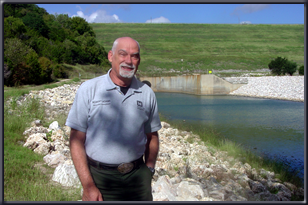 |
 |
||||||||||||||||||||||||||||||||||||||||||||||||||||
|
| |||||||||||||||||||||||||||||||||||||||||||||||||||||
By Year
By Award
|
Robert G. Adams Capitol Regional Office, Operations Division, Fort Worth District
Managing lands equaling the size of Vermont and New Hampshire is a challenge for Corps managers, and a big part of the challenge is ensuring that these properties are compliant with current federal, state and local environmental regulations. Forty year Corps veteran Robert Adams was named Environmental Compliance Employee of the Year for his ability to navigate the multitude of new laws enacted each year and ensure that the Corps’ Capitol Regional Office’s many operations comply with these laws. A big part of Adams’ job is to stay current with these environmental laws and to develop sometimes creative ways to comply with them. In one instance, laws regarding evaporation ponds for waste water disposal in parks were becoming more expensive to comply with since they were near an important aquifer, so Adams looked for other ways to deal with the wastewater. Once alternative effluent disposal systems are in place, the evaporation ponds will have to be closed to state standards. Developing closure plans using sources outside the Project carried a price tag of $100K. Plans developed ‘in house’ at the local level and approved by the responsible state agency cost less than $5K. Anytime a project is proposed on property the Corps of Engineers manages may adversely impacts critical habitat or the continued existence of federally/state listed threatened or endangered species, Adams consults with the U.S. Fish and Wildlife Service and/or the Texas Parks and Wildlife Department. In most instances, compliance requires mitigating a project’s damage to the environment. When nearby Fort Hood needed to expand and upgrade a firing range, it was determined that existing wetlands would be adversely impacted. Coordinating with several sections of the Corps, it was decided to mitigate the impact by expanding and enhancing a small wetlands located at Stillhouse Hollow Lake. Adams served as Project Manager for the development and construction of Brown’s Creek Mitigation Project. The project includes approximately 4,700 feet of dikes and water control structure which expanded a 20+ acre wetland adjacent to the lake. In addition, approximately 6,900 feet of ephemeral and intermittent stream watercourses that had been lost by due to agricultural practices (terracing) were re-established. Over 9,000 terrestrial trees and shrubs, native grasses, forbs and thousands of wetland plants were planted within the mitigation area. In every aspect of his job, Adams communicates with the public and co-workers about the necessity of complying with environmental laws in order to protect our natural resources for future generations. Communicating with younger compliance coordinators ensures knowledge is passed on to the next generation, since many current employees are retiring. "Each year, as part of the ERGO program, environmental compliance coordinators from each lake within the project visit each other’s lakes to look for EC deficiencies. These findings are uploaded into OMBIL and submitted to the District environmental compliance coordinator. I was quite surprised when I received notification of the award, Adams said. "Knowing the caliber and diversity of work being done throughout the Corps in the field of environmental compliance, I'm very honored by this recognition. Without the help of my co-workers at SWF, the Capital Regional Office, the lakes I work with, and the support of my supervisor, it never would have been accomplished." |
 Item is restricted to U.S. Army Corps of Engineers, CAC required. Document will open in a new window.
Item is restricted to U.S. Army Corps of Engineers, CAC required. Document will open in a new window.
